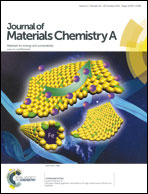An amperometric cholesterol biosensor with excellent sensitivity and limit of detection based on an enzyme-immobilized microtubular ZnO@ZnS heterostructure†
Abstract
The controlled synthesis of porous nanostructure materials and their use as active materials for cholesterol sensing are of key importance in current research due to their exceptionally high surface area, their optical and electrical properties, and their good electron transport characteristics. In the present study we have synthesized a microtubular ZnO@ZnS heterostructure from the corresponding ZnO microtubes by a simple aqueous chemical sulphidation process. ZnS microtubes have also been synthesized by removal of ZnO from the ZnO@ZnS heterostructure using acetic acid. Both ZnO@ZnS and ZnS microtubes have a high surface area (56 and 68 m2 g−1, respectively) and a modified electronic structure. A ZnO@ZnS heterostructure-modified electrode has excellent amperometric cholesterol-sensing performance, with sensitivity 52.67 mA M−1 cm−2, signal to noise (S/N) ratio = 15, and limit of detection (LOD) 0.02 mM with S/N = 3. The sensing performance of the ZnO@ZnS heterostructure, including both sensitivity and LOD, is superior to that reported either for ZnO-based or Au- or Pt-modified sensors. Its superior performance originates both from its high microstructure-based surface area and its modified electronic structure, which facilitate electron transport to the electrode.


 Please wait while we load your content...
Please wait while we load your content...